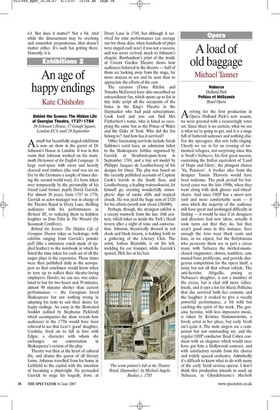An age of happy endings
Kate Chisholm Behind the Scenes: The Hidden Life of Georgian Theatre, 1737-1784 Dr Johnson's House, 17 Gough Square, London EC4, until 18 September Asmall but beautifully staged exhibition is now on show in the garret of Dr Johnson's House in London. It was in this room that Johnson worked on his mammoth Dictionary of the English Language. A large roof-space with eaves and heavily charred roof timbers (the roof was set on fire by the Germans a couple of times during the second world war), it's been taken over temporarily by the personality of his friend (and former pupil) David Garrick. For almost 30 years, from 1747 to 1776, Garrick as actor-manager was in charge of the Theatre Royal in Drury Lane, thrilling audiences with his performances as Richard III, or reducing them to helpless laughter as Don Felix in The Wonder (by Susannah Centlivre).
Behind the Scenes: The Hidden Life of Georgian Theatre takes us backstage, with exhibits ranging from Garrick's powder puff (like a miniature conch made of rippled leather) to the notebook in which he listed the time taken for each act of all the major plays in the repertoire. These times were then published daily in the newspapers so that coachmen would know when to turn up to collect their theatre-loving employers. Hamlet, we can see, was calculated to last for two hours and 39 minutes, almost 90 minutes shorter than current performances — the Georgians loved Shakespeare but saw nothing wrong in adapting his texts to suit their desire for happy endings. An essay in the illustrated booklet (edited by Stephanie Pickford) which accompanies the show reveals how audiences in the 1770s would have been relieved to see that Lear's 'good' daughter, Cordelia, lived on to fall in love with Edgar, a character with whom she exchanges no conversation in Shakespeare's version of the play.
Theatre was then at the heart of cultural life, and drama the queen of all literary forms. Johnson travelled from his home in Lichfield to the capital with the intention of becoming a playwright. He persuaded Garrick to stage his tragedy, Irene, at Drury Lane in 1749, but although it survived for nine performances (an average run for those days, when hundreds of plays were staged each year) it was not a success, and was never revived, much to Johnson's chagrin. Rowlandson's print of the inside of Covent Garden Theatre shows how audiences behaved in the theatre — half of them are looking away from the stage, far more anxious to see and be seen than to appreciate the efforts of the cast.
The curators (Fiona Ritchie and Natasha McEnroe) have also unearthed an extraordinary fan, which opens up to list in tiny italic script all the occupants of the boxes in the King's Theatre in the Haymarket who had paid subscriptions. Look hard and you can find Mrs Fitzherbert's name, who is listed as occupying the same box as the Prince of Wales and the Duke of York. Who did the fan belong to? And how has it survived?
Other fascinating survivals include Sarah Siddons's coral tiara, an admission ticket to the Shakespeare Jubilee organised by Garrick at Stratford-upon-Avon in September 1769, and a tiny set model by Philippe Jacques de Loutherbourg of his designs for Omai. The play was based on the recently published accounts of Captain Cook's travels in the South Seas, and Loutherbourg, a leading watercolourist, let himself go, creating wonderfully atmospheric slips of exotic cliffs and tropical clouds. He was paid the huge sum of £520 for his efforts (worth now about £30,000).
Perhaps, though, the strangest exhibit is a creepy waxwork from the late 18th century, which takes us inside the Turk's Head tavern after a night of wine and conversation. Johnson, theatrically dressed in red cloak and black tricorn, is holding forth to a gathering of the Literary Club. The artist, Joshua Reynolds, is on his left, wielding his ear trumpet, while Garrick's spaniel, Phil, lies at his feet.




















































 Previous page
Previous page